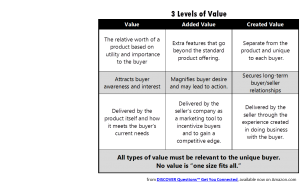 Sellers used to deliver on their buyer’s priority value. If a buyer preferred “made in the USA,” the seller offered products manufactured in America. As competitive pressures increased, marketers created “added value” to ensure buyer loyalty with everything from the old S&H Green Stamps to today’s Box Tops for Education. B2B selling followed suit, incentivizing buyers with various bonus programs.
Sellers used to deliver on their buyer’s priority value. If a buyer preferred “made in the USA,” the seller offered products manufactured in America. As competitive pressures increased, marketers created “added value” to ensure buyer loyalty with everything from the old S&H Green Stamps to today’s Box Tops for Education. B2B selling followed suit, incentivizing buyers with various bonus programs.
This is no longer sufficient. Today’s buyer wants “made in the USA” plus the standard added value AND something more. The “more” is undefined. Buyers don’t know exactly what they want, but they know what it is when they find it. Until they find it, they are always on the lookout for it.
Since a semi-satisfied buyer is unlikely to be loyal, this is problematic for sellers.
What causes this vague buyer dissatisfaction? It isn’t always attributable to price, product quality or corporate image. It isn’t necessarily a lack of value or a deficit in added value. Oftentimes, it’s a lack of value creation. The job of creating value falls squarely on the individual seller.
Creating value is not the same as adding value. The bar has been raised significantly by empowered consumers who are looking for better, more, different, special and unique.
Adding value is practically de rigueur in the course of regular business, and it takes many forms like customer incentives, no-cost options, loyalty programs and giveaways. It involves taking something with a value and adding it on for the buyer.
Creating value goes further. It requires identifying what would be of value to an individual buyer and then finding or making a way for that unique value to be realized. Unlike added value, created value is original and unique to the one buyer it suits.
Buyer demand for value creation has come about through a trickle-down effect. Companies began focusing on value creation to meet shareholder demands as competition escalated for many industries in the 1970s and 1980s. Now, 30-40 years later, buyers at every level want more, and they want it to come directly from sellers.
This is challenging because buyers don’t directly request value creation. Most buyers don’t even think in those terms. All they know is they want a little something more, something different from what everybody else is already getting.
Take a look at this illustration to better understand the differences between value, added value and created value. Give yourself and your company a quick evaluation. What value are you delivering and which type of value could you increase?
In addition to answering that question, sellers then must fill in the gaps. To do so, first consider what value is being offered but may not be recognized by your buyers. Don’t let what you offer be taken for granted. Remind buyers of the value your products deliver, the added value your company delivers and the extra special value you are creating.
Then, with your evaluation (based on your buyer’s unique values), find a way to add and create value. This does not have to be costly. Even asking insightful questions creates value when it makes the buyer think and leads to higher quality decisions. Figure out what your buyer needs and create value to meet that specific need.
Finally, be sure to keep in touch with what your buyer values. As their priorities change, the perception of what you’ve created may change, too. What was high value last year may be utterly irrelevant this year.
Empowered buyers buy from sellers who create unique value.






